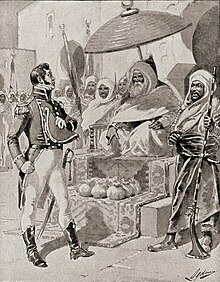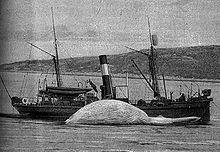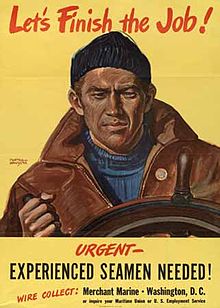History of the United States Merchant Marine
As an academic subject, it crosses the boundaries of standard disciplines, focusing on understanding the United States' relationship with the oceans, seas, and major waterways of the globe.Without the means or the authority to field a naval force necessary to protect their ships in the Mediterranean against the Barbary pirates, the nascent U.S. government took a pragmatic, but ultimately self-destructive route.A largely successful undeclared war with French privateers in the late 1790s showed that American naval power was now sufficient to protect the nation's interests on the seas.Because of rampant smuggling, the need was immediate for strong enforcement of tariff laws, and on August 4, 1790, the United States Congress, urged on by Secretary of the Treasury Alexander Hamilton, created the Revenue-Marine, later renamed Revenue Cutter Service in 1862.[12] In 1832, Secretary of the Treasury Louis McLane ordered in writing for revenue cutters to conduct winter cruises to assist mariners in need, and Congress made the practice an official part of regulations in 1837.The British government was farsighted enough to realize that the motive power of the immediate future was steam, and in 1839 heavily subsidized the Cunard Line, which began its career in 1840 with four side-wheeled wooden ships.The British Government, therefore, readily aided Samuel Cunard, as it did other owners, granting him a subsidy of $425,000 a year to carry the mails back and forth between Liverpool, Halifax, and Boston, with an occasional visit to Quebec.[13] This policy of subsidization, which was continued to at least WW II by Great Britain, aided materially not only in giving her maritime interests a start in the new type of ships, but in helping them win and hold supremacy on the ocean.[14] The first regular steamship service from the west to the east coast of the United States began on February 28, 1849, with the arrival of the SS California (1848) in San Francisco Bay.But more important than all else was the fact that more profitable investments in internal transportation and the exploration of raw materials in the great industrial age which dawned after the war drew capital away from the sea.As of 1876, Plimsoll marks were required on all U.S. vessels[8] In 1880, passenger steamship Columbia of the Oregon Railroad and Navigation Company became the first outside usage of Thomas Edison's incandescent light bulb and the first ship to use a dynamo.Under the Act's directive to "subserve and promote the postal and commercial interest of the United States," the Postmaster General invited bids under which contracts were subsequently awarded on routes which varied in number from four to nine.[30] The Belen Quezada, the first foreign ship flagged in the Panamanian registry, was employed in running illegal alcohol between Canada and the United States during Prohibition.[31] In addition to sidestepping the Seamen's Act, Panamanian-flagged ships in this early period paid sailors on the Japanese wage scale, which was much lower than that of western merchant powers.This was a major factor in galvanizing neutral opinion against the Central Powers, as countries like the United States suffered casualties and loss to their trade, and was one of the causes of the eventual entry of the US into the war.At the request of Congress, the chairman of the Maritime Commission, VADM Emory S. Land worked with ADM Russell R. Waesche, Commandant of the Coast Guard, to formulate a training program for merchant-marine personnel.[citation needed] Once convoys and air cover were introduced, sinking numbers were reduced and the U-boats shifted to attack shipping in the Gulf of Mexico, with 121 losses in June.It came to a head in the middle of the war with the writing of a column in the New York World-Telegram by Pegler, who alleged that merchant seamen refused to work on Sundays per union rules, causing sick USMC servicemen to unload their own supplies in an incident off Guadalcanal.But they denied the incident ever took place, and were backed by a report of Admiral William F. Halsey, commander of United States forces in the South Pacific, to the Navy Department in which Halsey praised the "co-operation, efficiency and courage" of the merchant seamen and asserted that "In no instance have merchant marine seamen refused to discharge cargo from their vessels or in any other way failed to co-operate with the United States forces ashore in that (South Pacific) area."The War Department, the same government branch that recruited them, opposed the Seaman's Bill of Rights in 1947 (see below) and managed to kill the legislation in congressional committee, effectively ending any chance for seamen to reap the thanks of a nation.For 43 years, the U.S. government denied them benefits ranging from housing to health care until Congress awarded them veterans' status in 1988, too late for 125,000 mariners, roughly half of those who had served.In the late 1940s, the Liberian open registry was formed as the brainchild of Edward Stettinius, who had been Franklin D. Roosevelt's Secretary of State during World War II.Immediately after its establishment, the NSA reactivated vessels to meet the urgent needs of America's European allies to help transport coal and other bulk materials to rebuild their defenses.In addition, a worldwide tonnage shortfall between 1951 and 1953 required the reactivation of over 600 ships to lift coal to Northern Europe and grain to India during the first years of the Cold War.Only hours before the advancing communists drove the U.N. forces from North Korea in December 1950, the vessel, built to accommodate 12 passengers, carried more than 14,000 Korean civilians from Hungnam to Pusan in the south.Junker, Commander of the Military Sea Transportation Service for the western Pacific, Admiral Joy noted that the success of the Korean campaign was dependent on the Merchant Marine.[54] The first constitution was drafted by Edward Reisman, Rudolph Wunsch, James Wilde, Everett Landers, Peter Geipi, and William Lovvorn,[55] who "wanted to craft a document that would provide for free and fair elections, set the terms of office for official positions, specify the duties of union officials, provide for charges, trials, and appeals, permit rank and file membership inspection of the union's financial records, and permit amendments by rank and file vote.[60] The crisis began on May 12, 1975, when Khmer Rouge naval forces operating former U.S. Navy "Swift Boats" seized the American container ship SS Mayagüez in recognized international sea lanes claimed as territorial waters by Cambodia and removed its crew for questioning.Surveillance by P-3 Orion aircraft indicated that the ship was then moved to and anchored at Koh Tang, an island approximately 50 miles (80 km) off the southern coast of Cambodia near that country's shared border with Vietnam.[65] "President Franklin D. Roosevelt called their mission the most difficult and dangerous transportation job ever undertaken," House Speaker Nancy Pelosi said at the ceremony, which was held at the U.S. Capitol and attended by congressional and military leaders.












United States Merchant MarineMaritime history of Colonial America 1776–1799 1800–1899 1900–19992000–Presentmaritime historyJames RiverJamestownRoyal NavyAmerican Revolutionary WarContinental CongressLetters of MarqueprivateersUnited States Coast GuardUnited States NavyAmerican RevolutionTreaty of AllianceBarbary piratesUnited States CongressWilliam BainbridgeAlgiersThomas JeffersonGeorge Washingtonundeclared warFirst Barbary WarTariff of 1789Protection papersUnited States of AmericatariffssmugglingSecretary of the TreasuryAlexander HamiltonDutch East India Companyfree tradeThe New American Practical NavigatorThis was one of the major factorsWar of 1812whalingNew BedfordMassachusettsNantucket IslandRobert FultonBoultonsteam engineNew York CityAlbany, New YorkBurlington, VermontJohn MolsonMontrealQuebecSt. LawrenceCanadaGreat LakesEmbargo Act of 1807Great BritainimpressmentJames MadisonFranceClipperUnited StatesBaltimore clipperschoonerChesapeake BayLetters of Marque and ReprisalFells Point, BaltimorespicesShanghaicannoncarronadeBlack Ball Linepacket shipsdroughtsCape VerdeNew Bedford, MassachusettsNew EnglandErie CanalSS Great EasternLouis McLaneSS Great WesternCunard LinePeninsular and Oriental Steam Navigation CompanyPacific Steam Navigation CompanySS California (1848)San Francisco BayNew York HarborCape HornSouth AmericaSan Francisco, CaliforniaCape of Good HopeFlying Cloud (clipper)Comet (clipper)U.S. Mail Steamship CompanyPacific Mail Steamship CompanyLight ListNotice to MarinersAndrew FurusethMarine Engineers' Beneficial AssociationMatthew Calbraith PerryConvention of KanagawapetroleumTitusvillePennsylvaniaEdwin L. DrakekerosenePanic of 1857steamshipRoyal CharterAngleseyMemphisAnchor LinesteamboatcompanyMississippi RiverSt. Louis, MissouriNew Orleans, LouisianaAmerican Civil WarSuez CanalEuropeCSS Alabamasloop-of-warcommissionedcommerce raidersCSS SumterCSS FloridaCSS Shenandoah

